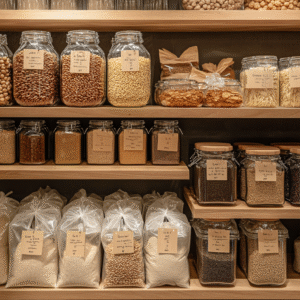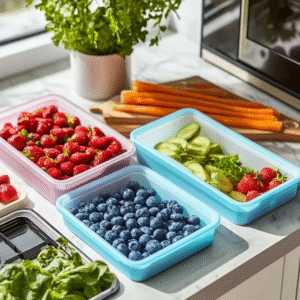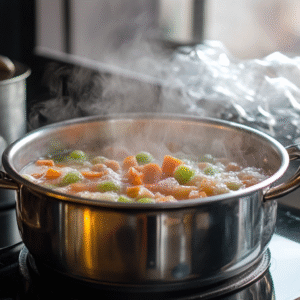1. Introduction: The Importance of Waste Reduction
Sustainable Vegan Living Tips center on minimizing food waste in the kitchen, transforming leftovers and scraps into valuable resources while reducing environmental impact. When we discard food, we not only lose the nutrition it could have provided but also contribute to landfill methane emissions—food waste accounts for roughly 8 % of global greenhouse gas emissions . Adopting plant-based cooking already lowers your carbon footprint; coupling it with deliberate waste-reduction strategies magnifies your positive effect on the planet. In this guide, you’ll learn how to plan smartly, store effectively, repurpose scraps, and compost responsibly—turning your kitchen into a zero-waste hub and embodying the ethos of Sustainable Vegan Living Tips.
2. Smart Shopping & Meal Planning
2.1 Inventory Audits & Weekly Menus
Begin each week by surveying your pantry, fridge, and freezer. Note items nearing their use-by dates—leafy greens wilting in the crisper, overripe fruits, or partial nut packages. Create a meal plan that prioritizes these ingredients: if spinach needs using, schedule a green smoothie or soup early in the week; if bananas have gone brown, earmark them for muffins or vegan ice cream. This habit ensures perishables become dishes, not trash.
2.2 Bulk Buys with Portion Control
Buying grains, legumes, and nuts in bulk reduces packaging waste, but requires measured portions to prevent spoilage. Use reusable glass jars equipped with labels indicating contents and purchase date. Portion rice or beans into 1-cup servings using silicone freezer bags—defrost only what you’ll cook. This approach aligns with Sustainable Vegan Living Tips by balancing package reduction with spoilage prevention.

3. Storage & Preservation Techniques
3.1 Optimized Refrigeration
Proper produce storage can double shelf life. Store mushrooms in paper bags to absorb moisture; wrap leafy greens in a damp cloth inside a sealed container to maintain humidity; keep herbs like parsley and cilantro upright in a water jar, loosely covered with a plastic bag. A small digital thermometer inside your fridge helps you maintain an optimal 2–4 °C, slowing microbial growth .
3.2 Freezing & Dehydration
For seasonal bounty—berries, herbs, tomatoes—freeze in single-serve portions on baking sheets before transferring to labeled freezer bags. Dehydrate excess produce like apple slices or zucchini ribbons in a low-temperature oven or dehydrator for use in granolas or snacks. These preservation methods extend edibles’ lifespan by months, fully embodying Sustainable Vegan Living Tips.

4. Repurposing Scraps & Creative Leftovers
4.1 Vegetable Stock & Broth
Collect carrot peels, onion ends, celery leaves, mushroom stems, and garlic skins in a zip-lock bag in the freezer. Once full, simmer with water, a bay leaf, and peppercorns for 45 minutes, then strain. Freeze broth cubes for quick soups—zero-waste and deeply flavorful.
4.2 Scrappy Sauces & Pest-o
Transform broccoli stalks, carrot tops, and herb stems into pesto by blending with garlic, nuts or seeds, olive oil, and lemon juice. Use leftover tomato skins and cores to create quick marinara: sauté with garlic, freeze-thawed skins, and canned tomatoes for 20 minutes. Each repurposed scrap aligns with Sustainable Vegan Living Tips by turning potential trash into culinary treasure.

5. Composting & Zero-Waste Systems
5.1 Home Composting Fundamentals
Embracing Sustainable Vegan Living Tips means diverting organic scraps from landfill into nutrient-rich compost. Start with a countertop bin fitted with a charcoal filter to capture odors—collect fruit peels, vegetable trimmings, coffee grounds, and eggplant scraps (from vegan recipes). Transfer these “greens” to a backyard compost pile or bin, layering with equal parts “browns” (shredded paper, dry leaves, cardboard) to balance nitrogen and carbon. Turn the pile weekly to aerate and accelerate decomposition; within 2–6 months, you’ll have dark, crumbly compost to enrich container gardens or raised beds. For detailed guidance, refer to the EPA’s home composting guide: EPA Composting at Home .
5.2 Vermicomposting with Worm Bins
If space is limited, vermicomposting offers a compact solution. Use a tiered worm bin filled with moistened coconut coir or shredded newspaper bedding. Feed red wiggler worms small portions of your kitchen scraps—coffee grounds, melon rinds, and leafy greens—and avoid citrus or onion overload. Harvest the worm castings every 8–12 weeks by separating the finished compost from active worms. This “black gold” provides highly concentrated nutrients for potted herbs or houseplants and exemplifies Sustainable Vegan Living Tips by closing the food-waste loop entirely.
5.3 Fermentation & Bokashi Buckets
Bokashi fermentation transforms all types of food waste—including cooked foods—into pre-compost through anaerobic fermentation. Layer scraps and Bokashi bran in a sealed bucket; drain excess liquid (bokashi tea) weekly to use as a plant fertilizer (diluted 1:100). After 2–4 weeks, bury the fermented mass in soil or add to your compost pile, where it will break down more rapidly. This method reduces odors and expands the range of compostable materials, reinforcing your zero-waste kitchen.
[imagem 1 ] seo-optimized-sustainable-vegan-composting.jpg
6. Tools & Sustainable Kitchen Materials
6.1 Reusable Storage Solutions
Ditch single-use plastics in favor of durable, reusable options. Replace cling film with beeswax or soy-wax wraps—washable and compostable at end of life. Swap disposable sandwich bags for silicone zip-lock pouches and opt for glass jars with airtight lids for bulk-purchased grains, legumes, and leftovers. Label each container with water-soluble markers indicating contents and date. These swaps embody Sustainable Vegan Living Tips by cutting packaging waste and ensuring food stays fresher, longer.
6.2 Eco-Friendly Utensils & Cookware
Upgrade to bamboo or FSC-certified wooden utensils, stainless-steel whisks, and silicone spatulas—materials that withstand high heat and resist bacterial growth. Choose cast-iron or ceramic-coated pans for even cooking without harmful non-stick chemicals. A sturdy Dutch oven doubles as an oven and stovetop cooking vessel, reducing the need for multiple pots. Investing in quality tools reduces turnover and landfill contributions.
6.3 DIY Cleaning & Zero-Waste Sponges
Minimize chemical runoff and plastic sponge waste by making your own cleaning supplies. Use Dr. Bronner’s castile soap diluted with water and a few drops of essential oil for all-purpose cleaning. Create zero-waste scrubbers by upcycling cotton or jute dishcloths, or purchase compostable loofah pads. Even your cleaning routine can reinforce Sustainable Vegan Living Tips through mindful material choices.
[imagem 2 ] seo-optimized-sustainable-vegan-tools.jpg
7. Ethical Sourcing & Minimal Packaging
7.1 Bulk Buying & Refill Stations
Reduce packaging waste by shopping at bulk-buy stores or refill stations for staples like rice, oats, nuts, seeds, and spices. Bring your own containers or use paper bags provided on site. Many co-ops and zero-waste grocers also offer cookware and cleaning supplies in bulk, supporting your Sustainable Vegan Living Tips—choose local shops when possible to cut food miles.
7.2 Farmer’s Markets & Community Supported Agriculture
Buying directly from farmers at markets or through CSAs (community supported agriculture) ensures fresh, seasonal produce with minimal plastic wrapping. Engaging with growers allows you to ask about their practices—organic, regenerative, or permaculture—reinforcing ethical food systems. Allocate a portion of your CSA share to share or swap excess with neighbors, further reducing waste.
7.3 Package-Free Online Retailers
For pantry items you can’t find locally, use online zero-waste retailers that ship in compostable or reusable packaging. Companies like Package Free Shop or Zero Waste Daniel curate sustainable household goods. Subscribe to refill delivery services for plant-milk concentrates or cleaning product tablets shipped in cardboard, eliminating single-use plastic. These options align with Sustainable Vegan Living Tips by extending waste-reduction beyond the kitchen.
8. Community Engagement & Resource Sharing
8.1 Neighborhood Compost & Tool Libraries
Many cities offer community compost drop-off sites—search local municipal programs or neighborhood Facebook groups. Alternatively, join a tool library where you can borrow seldom-used appliances (e.g., dehydrators for veggie crisps) instead of purchasing. Sharing resources decreases individual consumption and fosters collective responsibility for Sustainable Vegan Living Tips.
8.2 Food Rescue & Donation Networks
If you have excess produce from CSA shares or bulk buys, partner with food-rescue organizations (e.g., Food Rescue US) to redirect it to shelters and community kitchens. Apps like OLIO connect neighbors to share surplus ingredients and prepared dishes, reducing both food waste and food insecurity.
8.3 Workshops & Skill Swaps
Host or attend local workshops on topics like canning, fermenting, or soap-making—skills that transform kitchen scraps into long-lasting pantry staples. Organize recipe swaps focused on zero-waste vegan cooking, exchanging tips and surplus ingredients. These gatherings build social bonds around Sustainable Vegan Living Tips and spread knowledge organically.
9. Water & Energy Conservation in the Vegan Kitchen
9.1 Low-Water Cooking Techniques
Conserving water in the kitchen is a cornerstone of Sustainable Vegan Living Tips. Instead of washing vegetables under a continuous stream, fill a large bowl or sink basin to soak and rinse multiple items simultaneously. When steaming greens or grains, reuse the same pot of water for subsequent batches or for making broth, capturing nutrients that leach into the liquid. One-pot meals—such as curries, stews, and grain bowls—minimize water usage by cooking rice, beans, and vegetables together; the residual cooking liquid serves as both cooking medium and sauce, reducing the need for extra water or dishwashing.
9.2 Energy-Efficient Appliances & Cooking Methods
Reducing energy consumption amplifies your sustainable impact. Pressure cookers and electric pressure cookers (e.g., Instant Pot) can reduce cooking times by up to 70%, slashing both energy use and stove-top monitoring. Induction cooktops heat faster and with less wasted heat than gas or traditional electric coils, making them ideal for simmering soups or sautéing vegetables. Batch-cooking methods—roasting a large tray of root vegetables or lentils at once—optimize oven use: cook multiple dishes back-to-back while residual heat remains. Turning off ovens or stovetops a few minutes before cooking time ends allows retained heat to finish the job, conserving electricity or gas without sacrificing quality.
10. Upcycling Packaging & Creative Storage Solutions
10.1 Repurposing Glass Jars & Containers
Instead of recycling or discarding glass jars from pasta sauces, nut butters, or pickles, sanitize and reuse them for dry-ingredient storage—grains, legumes, seeds, or spices. Label each jar with chalkboard paint or reusable vinyl labels indicating contents and “best used by” date. Smaller jars hold homemade nut milk or plant-based yogurt; medium sizes become mason-jar salads or overnight oats. This practice reduces packaging waste and creates an organized, visible pantry where ingredients are less likely to be forgotten and spoil.
10.2 Textile Upcycling for Zero-Waste Wrapping
Instead of single-use plastic wrap or aluminum foil, employ upcycled fabric scraps to make DIY produce bags, bowl covers, and bread wraps. Cut 100% cotton or linen scraps into squares, hem the edges, and treat with a blend of melted beeswax or soy wax to create reusable food wraps. Old cotton t-shirts can become dish towels or cleaning rags, and thrifted tea towels serve as bread basket liners. By transforming textiles destined for landfill into kitchen essentials, you extend the life cycle of materials and embody Sustainable Vegan Living Tips through mindful reuse.
11. Digital Tools & Community Engagement
11.1 Apps & Trackers to Monitor Waste
Modern technology can aid your zero-waste journey. Apps like Olio facilitate sharing surplus food with neighbors, while Too Good To Go connects you with local restaurants or bakeries offering unsold items at a discount, preventing perfectly good products from becoming waste. Household food-waste trackers—whether a simple spreadsheet, digital sink diary, or dedicated app like Flashfood—help you quantify scraps and plate waste, revealing patterns that inform better meal planning and purchasing decisions.
11.2 Joining & Hosting Zero-Waste Challenges
Engage your community by organizing or participating in zero-waste challenges—30-day no-waste campaigns or “Repurpose a Recipe” contests shared on social media with #ZeroWasteVeganKitchen. Host local workshops or virtual meetups where participants exchange tips, show before-and-after pantry makeovers, and swap surplus ingredients. By collaborating, you not only reduce collective waste but also foster accountability, shared learning, and the spread of Sustainable Vegan Living Tips beyond your kitchen walls.
12. FAQ: Deep-Dive Answers
Q1: How do I prevent compost bins from attracting pests?
Use a sealed bin with a carbon filter for indoor scraps; bury outdoor kitchen scraps under a 6-inch layer of browns. Avoid adding meat or oily foods to prevent rodents.
Q2: Can I compost citrus peels and onion skins?
Yes—small amounts of citrus are fine if balanced with ample browns; onion skins decompose slowly but add nitrogen. Bokashi fermentation handles citrus and cooked scraps more effectively if your pile is slow to break them down.
Q3: What’s the best way to transition to a zero-waste kitchen?
Start small: replace one single-use item (e.g., cling film) at a time. Incorporate one new practice (e.g., freezing scraps for broth) weekly. Gradually build up to comprehensive Sustainable Vegan Living Tips without feeling overwhelmed.
13. Conclusion & Next Steps
Embracing Sustainable Vegan Living Tips transforms your kitchen into a model of resource efficiency and environmental stewardship. Implement smart shopping, optimized storage, creative repurposing, and composting systems to reduce waste dramatically. Enhance your efforts with durable tools, ethical sourcing, and active community engagement. Begin today by conducting a kitchen audit and choosing one new zero-waste practice—then build momentum. Share your progress and discoveries with #ZeroWasteVeganKitchen and subscribe at https://theveganvalkyrie.com/subscribe for ongoing tips, recipes, and community stories.
AFFILIATE OFFER: Elevate your sustainable lifestyle with our Zero-Waste Kitchen Masterclass—live workshops, expert Q&A, and a curated toolkit to help you succeed: [INSERIR LINK DE AFILIADO AQUI]